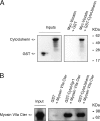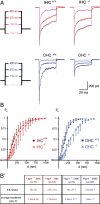Molecular characterization of the ankle-link complex in cochlear hair cells and its role in the hair bundle functioning
- PMID: 17567809
- PMCID: PMC6672440
- DOI: 10.1523/JNEUROSCI.0342-07.2007
Molecular characterization of the ankle-link complex in cochlear hair cells and its role in the hair bundle functioning
Abstract
Several lines of evidence indicate that very large G-protein-coupled receptor 1 (Vlgr1) makes up the ankle links that connect the stereocilia of hair cells at their base. Here, we show that the transmembrane protein usherin, the putative transmembrane protein vezatin, and the PDZ (postsynaptic density-95/Discs large/zona occludens-1) domain-containing submembrane protein whirlin are colocalized with Vlgr1 at the stereocilia base in developing cochlear hair cells and are absent in Vlgr1-/- mice that lack the ankle links. Direct in vitro interactions between these four proteins further support their involvement in a molecular complex associated with the ankle links and scaffolded by whirlin. In addition, the delocalization of these proteins in myosin VIIa defective mutant mice as well as the myosin VIIa tail direct interactions with vezatin, whirlin, and, we show, Vlgr1 and usherin, suggest that myosin VIIa conveys proteins of the ankle-link complex to the stereocilia. Adenylyl cyclase 6, which was found at the base of stereocilia, was both overexpressed and mislocated in Vlgr1-/- mice. In postnatal day 7 Vlgr1-/- mice, mechanoelectrical transduction currents evoked by displacements of the hair bundle toward the tallest stereocilia (i.e., in the excitatory direction) were reduced in outer but not inner hair cells. In both cell types, stimulation of the hair bundle in the opposite direction paradoxically resulted in significant transduction currents. The absence of ankle-link-mediated cohesive forces within hair bundles lacking Vlgr1 may account for the electrophysiological results. However, because some long cadherin-23 isoforms could no longer be detected in Vlgr1-/- mice shortly after birth, the loss of some apical links could be involved too. The premature disappearance of these cadherin isoforms in the Vlgr1-/- mutant argues in favor of a signaling function of the ankle links in hair bundle differentiation.
Figures










Similar articles
-
The very large G-protein-coupled receptor VLGR1: a component of the ankle link complex required for the normal development of auditory hair bundles.J Neurosci. 2006 Jun 14;26(24):6543-53. doi: 10.1523/JNEUROSCI.0693-06.2006. J Neurosci. 2006. PMID: 16775142 Free PMC article.
-
Fate of mammalian cochlear hair cells and stereocilia after loss of the stereocilia.J Neurosci. 2009 Dec 2;29(48):15277-85. doi: 10.1523/JNEUROSCI.3231-09.2009. J Neurosci. 2009. PMID: 19955380 Free PMC article.
-
Interaction of protocadherin-15 with the scaffold protein whirlin supports its anchoring of hair-bundle lateral links in cochlear hair cells.Sci Rep. 2020 Oct 2;10(1):16430. doi: 10.1038/s41598-020-73158-1. Sci Rep. 2020. PMID: 33009420 Free PMC article.
-
Usher protein functions in hair cells and photoreceptors.Int J Biochem Cell Biol. 2014 Jan;46:80-9. doi: 10.1016/j.biocel.2013.11.001. Epub 2013 Nov 12. Int J Biochem Cell Biol. 2014. PMID: 24239741 Free PMC article. Review.
-
Development of the hair bundle and mechanotransduction.Int J Dev Biol. 2007;51(6-7):597-608. doi: 10.1387/ijdb.072392gn. Int J Dev Biol. 2007. PMID: 17891720 Review.
Cited by
-
Liquid-liquid phase separation in hair cell stereocilia development and maintenance.Comput Struct Biotechnol J. 2023 Feb 24;21:1738-1745. doi: 10.1016/j.csbj.2023.02.040. eCollection 2023. Comput Struct Biotechnol J. 2023. PMID: 36890881 Free PMC article. Review.
-
Knockout of ush2a gene in zebrafish causes hearing impairment and late onset rod-cone dystrophy.Hum Genet. 2018 Oct;137(10):779-794. doi: 10.1007/s00439-018-1936-6. Epub 2018 Sep 21. Hum Genet. 2018. PMID: 30242501
-
The physiology of mechanoelectrical transduction channels in hearing.Physiol Rev. 2014 Jul;94(3):951-86. doi: 10.1152/physrev.00038.2013. Physiol Rev. 2014. PMID: 24987009 Free PMC article. Review.
-
Targeted next generation sequencing for molecular diagnosis of Usher syndrome.Orphanet J Rare Dis. 2014 Nov 18;9:168. doi: 10.1186/s13023-014-0168-7. Orphanet J Rare Dis. 2014. PMID: 25404053 Free PMC article.
-
Distinct expression and function of whirlin isoforms in the inner ear and retina: an insight into pathogenesis of USH2D and DFNB31.Hum Mol Genet. 2015 Nov 1;24(21):6213-28. doi: 10.1093/hmg/ddv339. Epub 2015 Aug 24. Hum Mol Genet. 2015. PMID: 26307081 Free PMC article.
References
-
- Adato A, Kikkawa Y, Reiners J, Alagramam KN, Weil D, Yonekawa H, Wolfrum U, El-Amraoui A, Petit C. Interactions in the network of Usher syndrome type 1 proteins. Hum Mol Genet. 2005a;14:347–356. - PubMed
-
- Adato A, Lefèvre G, Delprat B, Michel V, Michalski N, Chardenoux S, Weil D, El-Amraoui A, Petit C. Usherin, the defective protein in Usher syndrome type IIA, is likely to be a component of interstereocilia ankle links in the inner ear sensory cells. Hum Mol Genet. 2005b;14:3921–3932. - PubMed
-
- Alagramam KN, Yuan H, Kuehn MH, Murcia CL, Wayne S, Srisailpathy CRS, Lowry RB, Knaus R, Van Laer L, Bernier FP, Schwartz S, Lee C, Morton CC, Mullins RF, Ramesh A, Van Camp G, Hagemen GS, Woychik RP, Smith RJH. Mutations in the novel protocadherin PCDH15 cause Usher syndrome type 1F. Hum Mol Genet. 2001;10:1709–1718. - PubMed
-
- Appert-Collin A, Baisamy L, Diviani D. Regulation of G protein-coupled receptor signaling by A-kinase anchoring proteins. J Recept Signal Transduct Res. 2006;26:631–646. - PubMed
Publication types
MeSH terms
Substances
LinkOut - more resources
Full Text Sources
Other Literature Sources
Molecular Biology Databases
